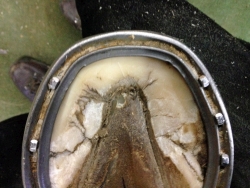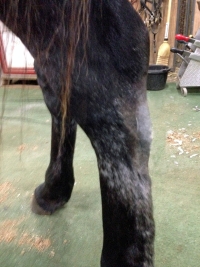Last fall, a client was breaking one of the yearlings in his barn. After the colt started to jog regularly, we noticed this colt’s propensity to knuckle over.
 (Photos by the author) Fig. 1: Squaring the toes of a colt's hind shoes can help reduce stumbling.
(Photos by the author) Fig. 1: Squaring the toes of a colt's hind shoes can help reduce stumbling.
It is not uncommon for a young horse to do this until it builds up a stronger rear end from the exercise they are now doing. While the young horse is adapting to a life of regular jogging and training, we can do some altered shoeing to help these horses get used to the new routine.
Since this specific horse was “knuckling over behind” (stumbling over his hind toes) we decided to square those hind shoes (Fig. 1) in an effort to reduce the stumbling. This was done while shoeing the yearling for the second time since the onset of regular jogging. The knuckling over was improved by keeping the toe length as short as comfortably possible and using the square-toe shoes, a standard “fix.”
By the third shoeing interval, that same horse had “popped a curb” (Fig. 2) which is inflammation of the plantar tarsal ligament (plantar meaning back of hind leg, tarsal meaning hock). The curb revealing itself was the “ah-ha” moment for us in terms of understanding why this horse was knuckling over to begin with. Performance horses are terrific at adapting to, and compensating for, pain. If lifting the hind leg higher aggravated the pain in that plantar tarsal ligament, the horse would then bring the limb forward in a lower swing arc. This would allow the toe to drag on the ground, causing a knuckling over. These animals are remarkably able to make subtle compensations at times--without notice--until they become more acute.
Horsemen often pick up on these subtle changes early; however, it sometimes requires a bit more time to put a finger on the exact problem. Standardbreds are often very stoic and their two-beat gait allows more room for the horse to compensate than say, a Thoroughbred with a four-beat gait.
 Fig. 2: The colt in question "popped a curb," which meant that it was knuckling over to avoid pain in that plantar tarsal ligament.
Fig. 2: The colt in question "popped a curb," which meant that it was knuckling over to avoid pain in that plantar tarsal ligament.
Having recently attended the 14th International Hoof Care Summit in Cincinnati, I’m reminded of how often I have heard researchers make statements on how tough the Standardbred breed is. At a conference many years ago, Dr. Bill Moyer referred to the Standardbred as “one tough horse.” It made me proud of our breed to hear him say that.
We often see our breed of horse competing at elite levels with issues that would stop other competitive styles of equine performance. This is both a blessing and a curse. Since we are decidedly a performance-based industry, it becomes natural to focus our shoeing changes based solely on that aspect of each horse. But when a horse requires constant shoeing changes, it is often necessary to look well beyond the gait, interference, and last quarter times to find the root of a problem.
It is always easy to apply what we know and “fix” a symptom. It is often far more difficult to understand the true cause of the problem. I believe the ability of the performance horse to adapt while competing far surpasses my ability to understand what they are capable of in those circumstances. All I can do is to keep on learning.
The things I find most useful in working with these incredible athletes is more time with each horse and an open mind. If I am simply grinding out shoeing jobs as fast as I can, opportunities are lost. If I get caught in the trap of “standard operating procedure,” then all thought process has stopped, a window of learning is unopened, and the animal is underserved.
Research continues to show us how much is not known about the racehorses we love to admire. Sometimes they perform well because of our efforts; other times they perform well despite of those efforts. Maybe that is why we admire them so.
I saw that 2-year-old with the curb recently. The curb has been treated, and his ears were up as he came back from the track. The horse looked happy and seemed well. I suppose he is just one more tough horse.
Veteran Standardbred farrier Steve Stanley of Lexington, Ky., authors a monthly column for Hoof Beats, the official harness racing publication of the U.S. Trotting Association. The American Farriers Journal Editorial Advisory Board member offers plenty of practical advice that will be of special interest regardless of the type of horses that you work with. Click here to read more from Steve Stanley's Hoof Beats series.








Post a comment
Report Abusive Comment